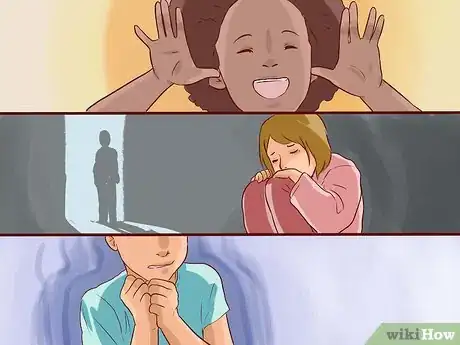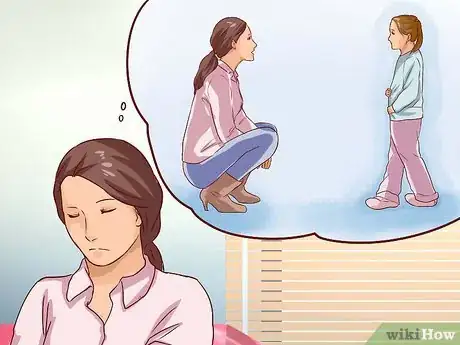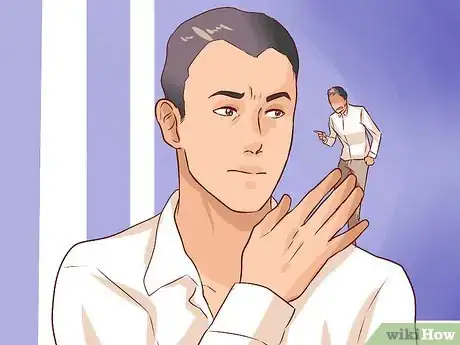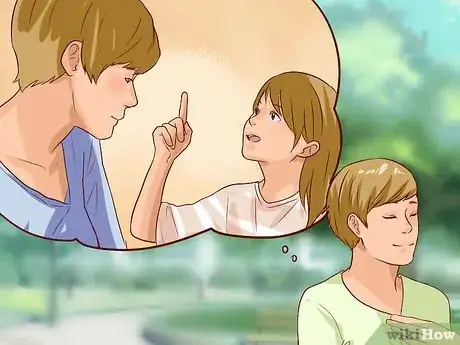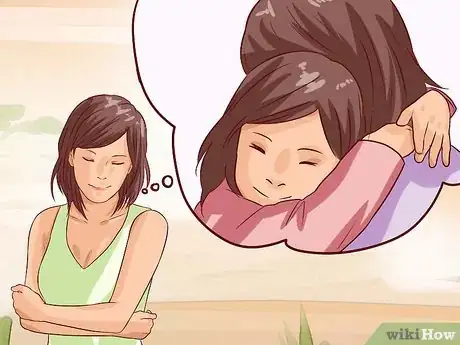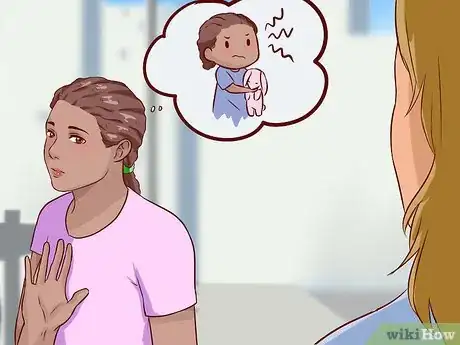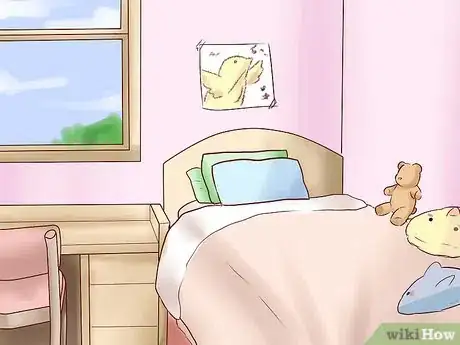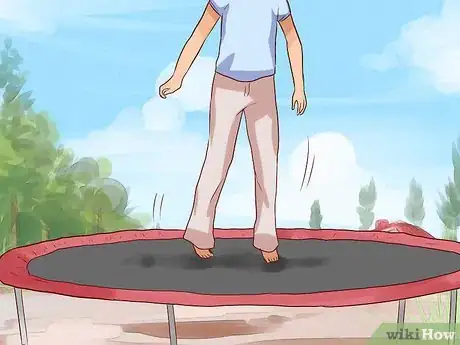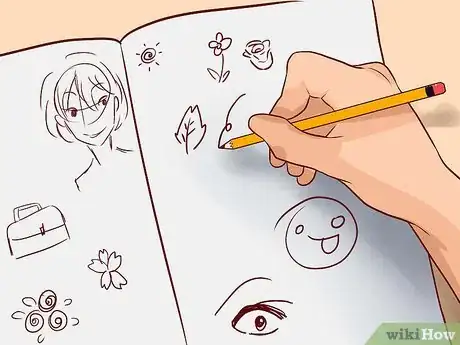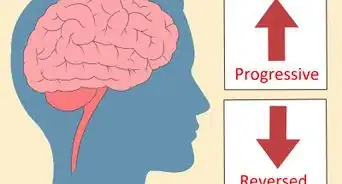This article was co-authored by Tasha Rube, LMSW. Tasha Rube is a Licensed Social Worker based in Kansas City, Kansas. Tasha is affiliated with the Dwight D. Eisenhower VA Medical Center in Leavenworth, Kansas. She received her Masters of Social Work (MSW) from the University of Missouri in 2014.
There are 10 references cited in this article, which can be found at the bottom of the page.
wikiHow marks an article as reader-approved once it receives enough positive feedback. This article received 14 testimonials and 95% of readers who voted found it helpful, earning it our reader-approved status.
This article has been viewed 253,592 times.
The concept of "the inner child" is that deep within each of us is the memory of the child outgrown. And this "inner child" continues to live and interact with the present, even as it reflects the past. The inner child is the source of a person's vitality and creativity. Developing a relationship with your inner child can also heal emotional problems that result from not honoring that part of yourself or even damage from a traumatic childhood. Life in the adult world can threaten to extinguish your inner child's flame, but you can fight back against those pressures by embracing and reconnecting with your childhood source.
Steps
Meeting Your Inner Child
-
1Reconnect with your childhood. One way to rekindle the relationship with your inner child is to "time travel" back to your childhood. Do this by making a list of things that brought you joy when you were young. Explore these lovely memories and try to recall that childhood wonder.[1] Revisiting these activities is also a good idea. Some ideas:
- Sports, whether that's soccer, football, basketball, baseball, or something else.
- Exploring the woods. A yummy picnic is a great idea.
- Playing pretend. This can be dressing up and having a tea party or even fighting off a band of mean, sneaky pirates.
- Color, whether in a child's or adult coloring book.
- Indulge in a favorite childhood treat, whether it is a favorite cereal, something your mom would make you, or a specific kind of candy.
- YA and/or fantasy novels, some of which are still read by adults. Examples include the Narnia series and the Time Quintet.
-
2Identify your specific inner child. Although everyone has different childhoods, there are patterns common to most people. If the relationship with your inner child has dwindled over the years, try to identify what stage of development your childhood is in now. This will help you create a roadmap for bringing your inner child back into your life. Note that there are some common themes one's "inner child" can have. These examples tend to be what your inner child is "mostly". [2] Some examples are:
- The abandoned child. This inner child often comes about as a result of parents divorcing or being too busy to spare attention. Or it can be severe, in the cases of abuse or neglect. Some of the clues are fears of being abandoned and feeling lonely or insecure.
- The playful child. This child is a healthy, often neglected aspect of adulthood. The playful child wants to have spontaneous fun and live life free from guilt or anxiety.
- The fearful child. This child probably received a lot of criticism as a child and experiences anxiety whenever it fails to get enough affirmation.
Advertisement -
3Write a letter to your inner child. This can be an apology if you feel like you've neglected your inner child and want to repair that connection. It can also be a simple letter expressing your desire to strengthen the friendship.
- Tailor your letter to the type of inner child you have. If she is fearful, try to reassure her and soften those fears. If she's worried about being abandoned, let her know that you will do your best always to be there for her. If she is playful, tell her you want to honor that lighthearted freedom.
-
4Cultivate an open space. Your inner child is a vulnerable person. She may need a safe space before she shows herself. Many people hide or deny the existence of the inner child because they think it makes them look weak. To let your inner child shine through, be gentle and affirming. Approach her softly, like a small animal whose trust you want to gain.
- Sit quietly and tell your inner child that you want to know more about her, that you're available to talk, and that you want her to feel safe. This may sound silly, but what you're doing is accessing another part of yourself and your unconscious mind.
-
5Listen to your feelings. One important way to get in touch with your inner child is to pay close attention to feelings that pop up in your daily life. These can be traced back to many of the wonderful and painful experiences of childhood when you were young and impressionable. The inner child's fears and insecurities, as well as her joys and feelings of wonder, often unfold into the emotional patterns of our adult lives.
- Throughout the day, check in with yourself. Ask, "what am I feeling right now?" Try to put words to these feelings.
-
6Be mindful of your inner critic. One of the biggest obstacles to giving your inner child the attention and care she needs is a critical voice. This voice can tell you that you're too old to have childlike insecurities or embrace the silliness of childhood.
- The inner critic begins to develop in childhood; it's a reaction to the inner child being stifled.[3] Respect your inner critic, as part of your inner child who has been let down or hurt, but avoid buying into negative self-talk.
- Respond to your inner critic by saying: "I understand where you're coming from. I understand that you're hurt. I'm here for you."
- Another helpful phrase: "Yes, this is a little silly. But this is what I'm supposed to be doing right now. Can you please take a break and let me do this?"
Nurturing Your Inner Child
-
1Take your inner child seriously. You may be tempted to push your inner child away because her problems seem irrelevant to your life as an adult. This isn't true, however, since many of our deepest feelings are carried forward by the inner child. Avoid the temptation of disregarding or ignoring your inner child. She can't be sidestepped.[4]
- Listen to her like you would an actual child in front of you. She's just as real and her feelings matter just as much.
-
2Accept your inner child’s feelings. You may experience frustration if feelings of anger or insecurity well up inside you. It's important to let yourself feel this energy, however, because this is the inner child speaking to you.
- She may throw a tantrum or get sorrowful. You can accept these emotions without "giving in" to them. Acknowledge them and then move on without letting them dictate your actions.
-
3Use re-parenting to heal. Re-parenting is based on the idea that as an adult you now possess the knowledge and resources to give your inner child what she needs.[5] If you feel like your inner child needs some healing before she can show up in your life at her best, this can be a good approach to try. You know better than anyone what she needs, based on hurtful experiences in her past, and how to help.
- For example, if your parents never gave you a birthday party, throw one for yourself. Invite your friends and tell them you're making up for this part of your childhood.
- For another example, affirm yourself when you know you've done something you can be proud of. Say "I'm proud of myself and my achievements."
-
4Protect your inner child. Although you want to avoid being held back by childhood fears, it's a good idea to be sensitive to your inner child's needs as well. If you have particular insecurities that you haven't fully overcome, respect them. You may have a fear of heights that first showed up in childhood. Be kind to the part of you that's still unsure about high diving boards or climbing.
- Also, stay out of toxic situations. If being around specific people reinforces childhood anxieties, limit contact with those individuals. For example, if you have a brother who picks on you and makes you feel bad about yourself, avoid spending more time with him than necessary.
-
5Organize your living area. Make your home more open to the playfulness of childhood.[6] Changing your environment will change the way you feel, so inject some childlike spontaneity and creativity into your life. Research shows that things as simple as different hues can affect mood.[7] Place familiar objects like trophies or stuffed animals on your mantle. Dig up old pictures of you and your family to put around the house. Try sprucing up the color of your walls, either by painting them or hanging light-hearted artwork.
Developing your Sense of Fun
-
1Play hide and seek. If you have children or nieces/nephews, get them to play with you. Getting your adult friends involved can also be fun. There's a whole psychology behind hide and seek that says it's a life-affirming game of exploration and being loved.[8]
-
2Buy a trampoline or use someone else's. You could even rent a bouncy house for a day and invite all of your friends. The physical activity will help you burn off stress, and the experience will remind you of how much you enjoyed bouncing as a child.[9]
-
3Fingerpaint, draw, or buy a coloring book. These activities will help you tap into your childhood creativity, where objects you draw aren't just things on a page, but open up entire emotional worlds. Research suggests that drawing helps children express their emotions, which they aren't aware of yet in the same way than adults can be.[10] Drawing and other visual arts can help your inner child express herself.
-
4Throw a dance party. Dancing can help you burn off stress like other physical activity, and it's also a creative avenue of expression that spans different age groups. Everyone loves to dance, from childhood all the way to old age. Use dance to connect with your inner child in a way that also honors your adulthood desires and interests.
- Make sure to include songs from your childhood in the playlist!
-
5Try free-writing or free-drawing. This involves letting your conscious mind rest while other parts of yourself take over. It can be a powerful source of creativity and fun, especially if you set the intention of letting your inner child express herself as she sees fit.
- Use crayons, colored pencils, or colored paper to make things more fun.
References
- ↑ http://www.creativecounseling101.com/innerchild.html
- ↑ https://healthpsychologyconsultancy.wordpress.com/2012/04/21/who-is-your-inner-child/
- ↑ https://www.psychologytoday.com/blog/stop-caretaking-the-borderline-or-narcissist/201411/more-questions-about-the-inner-critic
- ↑ https://www.psychologytoday.com/blog/evil-deeds/200806/essential-secrets-psychotherapy-the-inner-child
- ↑ https://books.google.com/books?id=YZFEzl4SuU4C&pg=PA163&lpg=PA163&dq=reparenting+psychology&source=bl&ots=skdIib0Fwo&sig=h1wKYNUfnN0GGopHeXPG8ggTx58&hl=en&sa=X&ved=0CFkQ6AEwCWoVChMI24PYrvH5xgIVwZQNCh301AbJ#v=onepage&q=reparenting%20psychology&f=false
- ↑ http://kerrybrook.ca/resources_articles_books_counselling/inner-child
- ↑ http://sgo.sagepub.com/content/4/1/2158244014525423
- ↑ https://www.psychologytoday.com/blog/learning-play/200912/hide-and-seek
- ↑ http://www.adaa.org/understanding-anxiety/related-illnesses/other-related-conditions/stress/physical-activity-reduces-st
Warnings
- Avoid people who think it's immature to be silly. These people probably have an overactive inner critic and don't recognize the importance of their inner child.⧼thumbs_response⧽
- Avoid going so far into child mode that you neglect your adult responsibilities. Find a balance that works for you.⧼thumbs_response⧽
About This Article
To embrace your inner child, try reintroducing things from your childhood to your life and getting in touch with your emotions. Eat your favorite childhood snack, watch a family movie, or play a game you used to love to help you remember what being a child felt like. You can also place old photos or toys around the house to remind you. Pay attention to your emotions as you reconnect with your childhood and try to understand them as an adult. Try writing a letter to your inner child to let them know that you’re there for them and you want to reconnect. If you find negative feelings arising from your past, try to treat yourself like you wanted to be treated as a child. For example, if your parents never let you play video games, have a fun gaming night. For more tips from our co-author, including how to identify your inner child’s personality, read on!

